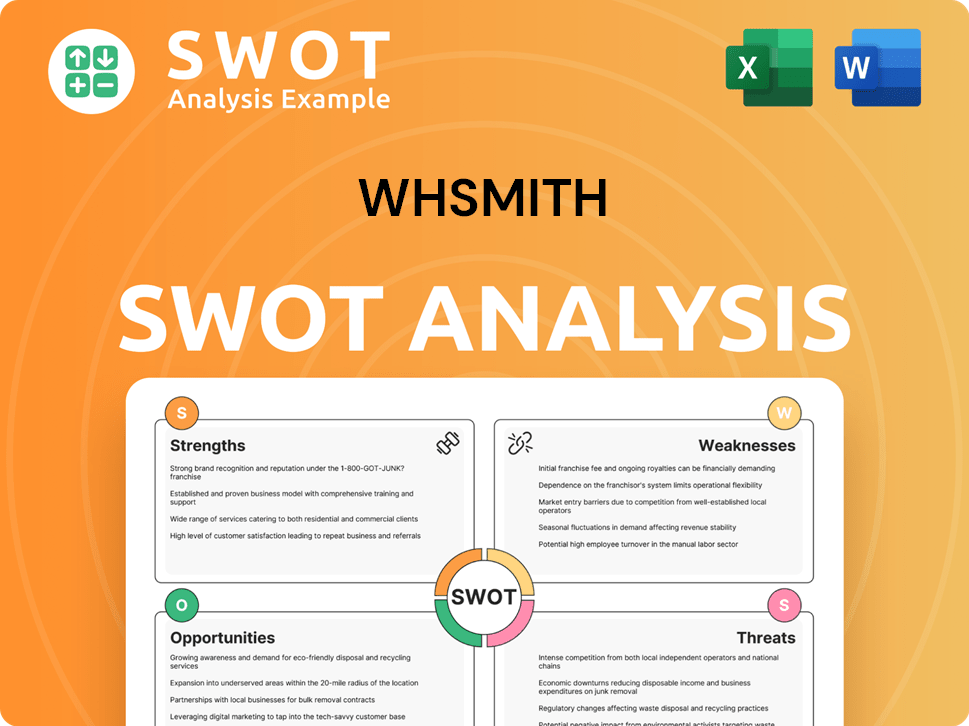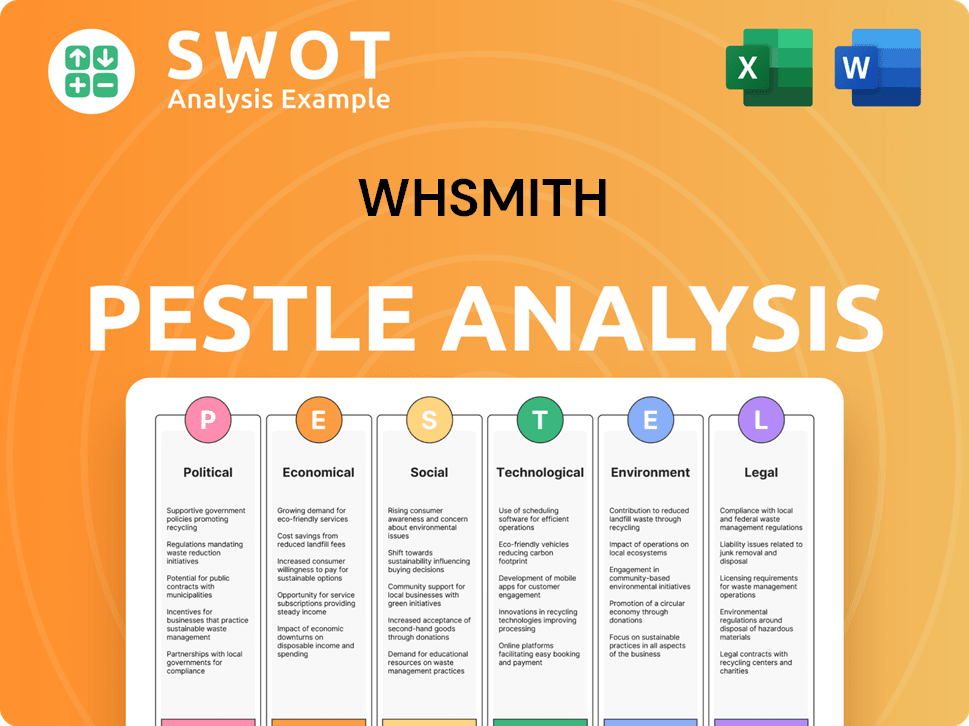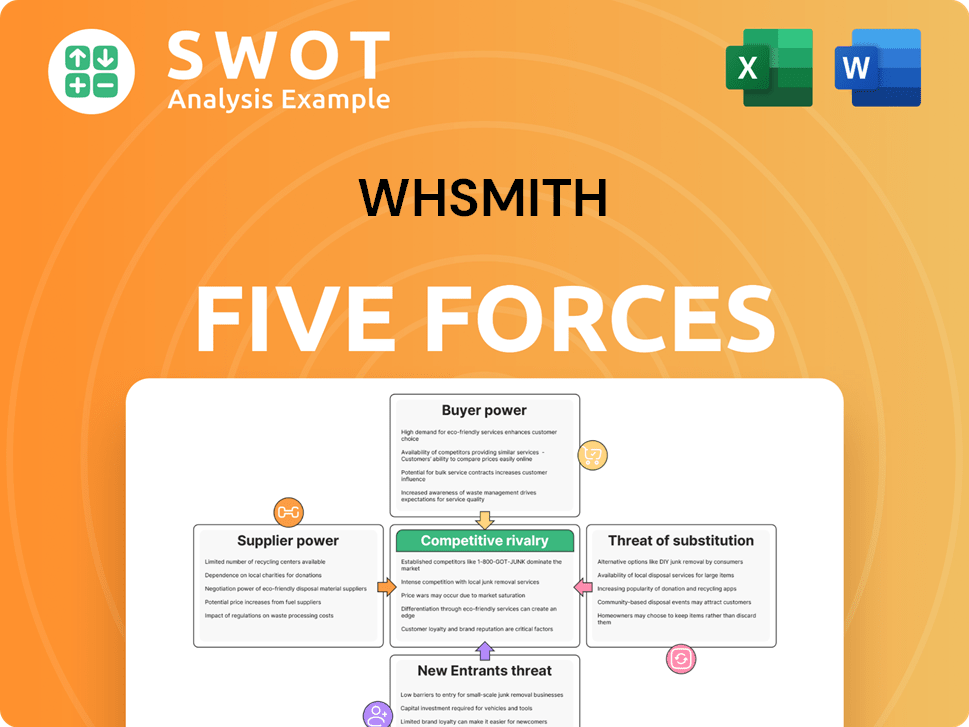WHSmith Bundle
Who Really Owns WHSmith?
Ever wondered who steers the ship at one of the world's oldest and most recognizable retailers? From its humble beginnings as a news vendor in 1792, WHSmith has transformed into a global powerhouse. Understanding the WHSmith SWOT Analysis is crucial for investors. This article unravels the WHSmith ownership structure, offering a comprehensive look at the company's evolution.

The journey of WHSmith, from a family-run business to a publicly traded entity, is a fascinating study in corporate governance. Knowing who owns WHSmith is key to understanding its strategic direction and future prospects. This analysis explores the WHSmith company's ownership, from its historical roots to its current major shareholders and the influence of its board of directors, providing valuable insights for investors and business strategists alike. We'll also delve into the WHSmith history and its parent company.
Who Founded WHSmith?
The story of WHSmith began in 1792 with Henry Walton Smith and his wife, Anna. They started a small news stand in London, marking the genesis of what would become a retail giant. The initial ownership structure was straightforward, rooted in family control from the outset.
As a family business, the ownership of WHSmith stayed within the Smith family for several generations. In 1816, William Henry Smith took over the business, expanding its newspaper delivery services. The firm was later renamed W. H. Smith & Son in 1840, reflecting the growing involvement of his sons, William Henry Smith II and Frederick Smith.
Early ownership of WHSmith was characterized by direct family control. This meant decisions were often made with a long-term perspective, focused on the sustainable growth of the business rather than immediate financial gains. There are no public records of external investors during this early phase, indicating organic growth fueled by reinvested profits.
The early ownership of WHSmith was a family affair, with control and decision-making resting firmly within the Smith family. This structure shaped the company's values and strategic direction from its inception. The absence of external investors or public shareholders in the early years allowed for a focus on long-term growth and the development of a strong brand identity.
- Family Control: The business was entirely family-owned and operated.
- Organic Growth: Expansion was funded through reinvested profits, not external investment.
- Long-Term Vision: Decisions were made with a focus on sustainable growth.
- No Public Disclosure: Ownership changes and disputes were internal family matters.
WHSmith SWOT Analysis
- Complete SWOT Breakdown
- Fully Customizable
- Editable in Excel & Word
- Professional Formatting
- Investor-Ready Format

How Has WHSmith’s Ownership Changed Over Time?
The evolution of WHSmith's ownership is marked by its 1973 initial public offering (IPO), a pivotal moment that transitioned the business from private, family control to a publicly traded entity on the London Stock Exchange. This move broadened the shareholder base to include both institutional and individual investors. While the exact market capitalization at the time of the IPO isn't readily available, the event fundamentally reshaped the company's ownership landscape.
Following its IPO, the major shareholding of WHSmith has largely been dominated by institutional investors. These include asset management firms, mutual funds, and index funds, which collectively hold a significant portion of the company's shares. This shift has significantly influenced corporate strategy, focusing on shareholder value, operational efficiency, and global expansion, particularly within the travel retail sector.
| Shareholder | Approximate Stake (Early 2025) | Type |
|---|---|---|
| BlackRock, Inc. | 7.5% | Asset Management Firm |
| The Vanguard Group | 3.2% | Asset Management Firm |
| Legal & General Investment Management | Notable | Asset Management Firm |
As of early 2025, key institutional shareholders of WHSmith include BlackRock, Inc., holding approximately 7.5% of the shares, and The Vanguard Group, with around 3.2%. Legal & General Investment Management also maintains a significant stake. These institutional investors wield considerable influence over corporate governance through their voting rights at annual general meetings. Individual insider holdings, such as those of the executive board and non-executive directors, typically constitute a smaller percentage, aligning their interests with the company's overall performance. This ownership structure reflects a broader trend in publicly traded companies, where institutional investors play a crucial role in shaping strategic direction and financial outcomes.
WHSmith transitioned from private to public ownership through its 1973 IPO, broadening its shareholder base. Institutional investors, such as BlackRock and The Vanguard Group, now hold a significant portion of the shares, influencing corporate strategy.
- Institutional investors play a key role in WHSmith's corporate governance.
- Individual insider holdings are typically a smaller percentage of total shares.
- The company's focus is increasingly on shareholder value and global expansion.
- The travel retail sector has been a key growth driver.
WHSmith PESTLE Analysis
- Covers All 6 PESTLE Categories
- No Research Needed – Save Hours of Work
- Built by Experts, Trusted by Consultants
- Instant Download, Ready to Use
- 100% Editable, Fully Customizable

Who Sits on WHSmith’s Board?
As of mid-2025, the WHSmith Board of Directors includes a mix of executive and non-executive directors, ensuring a balance of internal management and external oversight. The board typically comprises the Chief Executive Officer, the Chief Financial Officer, and independent non-executive directors, along with a Chairman. This structure is designed to support effective corporate governance and represent shareholder interests. The current board members include Carl Cowling as Group Chief Executive Officer, Robert Moorhead as Group Chief Financial Officer, and Annette Court as the Chair of the Board.
Independent non-executive directors play a crucial role by bringing external expertise and providing oversight, which helps balance the interests of management and shareholders. This setup is vital for maintaining accountability and ensuring that the company's decisions align with its long-term strategic objectives and financial performance. The composition of the board reflects a commitment to sound corporate governance, designed to ensure that the company operates in the best interests of all stakeholders. For more information about the company's growth strategy, you can read about the Growth Strategy of WHSmith.
| Board Member | Position | Role |
|---|---|---|
| Carl Cowling | Group Chief Executive Officer | Executive Director |
| Robert Moorhead | Group Chief Financial Officer | Executive Director |
| Annette Court | Chair of the Board | Non-Executive Director |
WHSmith operates under a one-share-one-vote structure, ensuring that each ordinary share has one vote. This system provides proportional voting power for all shareholders, with no special voting rights or dual-class shares that would give outsized control to any individual or entity. Major institutional shareholders, such as BlackRock and Vanguard, hold significant stakes and exert influence through their voting power, which is proportionate to their holdings. The board's structure is designed to ensure accountability to the broader shareholder base.
The WHSmith ownership structure is designed to ensure fair representation and accountability. This structure includes a mix of executive and non-executive directors on the board. The board's composition and voting structure are designed to ensure accountability to the broader shareholder base.
- One-share-one-vote structure.
- Major institutional shareholders have significant influence.
- The board includes a mix of executive and non-executive directors.
- No special voting rights or dual-class shares exist.
WHSmith Business Model Canvas
- Complete 9-Block Business Model Canvas
- Effortlessly Communicate Your Business Strategy
- Investor-Ready BMC Format
- 100% Editable and Customizable
- Clear and Structured Layout

What Recent Changes Have Shaped WHSmith’s Ownership Landscape?
Over the past few years (2022-2025), the ownership profile of the company has been shaped by its strategic moves, particularly its expansion in the travel retail sector. Acquisitions, such as the purchase of Marshall Retail Group and InMotion in North America, have been pivotal in driving revenue growth and increasing market share. These acquisitions often involve a mix of debt and equity financing, which can cause some changes in the capital structure. However, specific details about secondary offerings related to these deals are not always prominently highlighted as major shifts in ownership.
Industry trends show a growing consolidation within the retail sector and a rise in institutional ownership. Large asset managers are playing a more significant role in corporate governance. The company aligns with this trend, as institutional investors remain the dominant shareholders. While there haven't been major founder departures in recent years, leadership changes at the executive level can indirectly influence investor confidence and ownership dynamics. The company's resilience post-pandemic and its strong performance in the travel sector have likely maintained investor interest and stability in its ownership base. There have been no public statements by the company or analysts suggesting a potential privatization or a significant shift away from its current public listing structure in the immediate future, indicating a continued commitment to its current ownership model. The company's focus remains on organic growth and strategic acquisitions within its travel retail segments, which are supported by its current diverse shareholder base.
| Metric | Data | Source/Year |
|---|---|---|
| Market Capitalization (approx.) | £1.2 billion | Financial Times, May 2024 |
| Institutional Ownership | Approximately 70% | Company Filings, 2024 |
| Revenue Growth (Travel Retail, 2023) | +28% | Company Annual Report, 2023 |
The company's ownership structure reflects a stable environment, with institutional investors continuing to hold a significant portion of the shares. The company's strategic moves, such as acquisitions in the travel retail sector, have been key drivers of its growth. The company's focus on the travel retail segment, supported by a diverse shareholder base, suggests a continued commitment to its current ownership model. For more insights, you can explore the Competitors Landscape of WHSmith.
The company is primarily owned by institutional investors. The ownership structure is stable, with no major shifts reported recently. The company remains listed on the London Stock Exchange.
Major shareholders include large asset management firms. These institutional investors play a significant role in the company's governance. Ownership is well-diversified among these key players.
The company continues to expand its travel retail operations. Acquisitions have been a key strategy for growth. The company's financial performance has been robust in recent years.
The company is expected to maintain its focus on travel retail. Further acquisitions and organic growth are anticipated. The current ownership model is expected to remain stable.
WHSmith Porter's Five Forces Analysis
- Covers All 5 Competitive Forces in Detail
- Structured for Consultants, Students, and Founders
- 100% Editable in Microsoft Word & Excel
- Instant Digital Download – Use Immediately
- Compatible with Mac & PC – Fully Unlocked

Related Blogs
- What are Mission Vision & Core Values of WHSmith Company?
- What is Competitive Landscape of WHSmith Company?
- What is Growth Strategy and Future Prospects of WHSmith Company?
- How Does WHSmith Company Work?
- What is Sales and Marketing Strategy of WHSmith Company?
- What is Brief History of WHSmith Company?
- What is Customer Demographics and Target Market of WHSmith Company?
Disclaimer
All information, articles, and product details provided on this website are for general informational and educational purposes only. We do not claim any ownership over, nor do we intend to infringe upon, any trademarks, copyrights, logos, brand names, or other intellectual property mentioned or depicted on this site. Such intellectual property remains the property of its respective owners, and any references here are made solely for identification or informational purposes, without implying any affiliation, endorsement, or partnership.
We make no representations or warranties, express or implied, regarding the accuracy, completeness, or suitability of any content or products presented. Nothing on this website should be construed as legal, tax, investment, financial, medical, or other professional advice. In addition, no part of this site—including articles or product references—constitutes a solicitation, recommendation, endorsement, advertisement, or offer to buy or sell any securities, franchises, or other financial instruments, particularly in jurisdictions where such activity would be unlawful.
All content is of a general nature and may not address the specific circumstances of any individual or entity. It is not a substitute for professional advice or services. Any actions you take based on the information provided here are strictly at your own risk. You accept full responsibility for any decisions or outcomes arising from your use of this website and agree to release us from any liability in connection with your use of, or reliance upon, the content or products found herein.